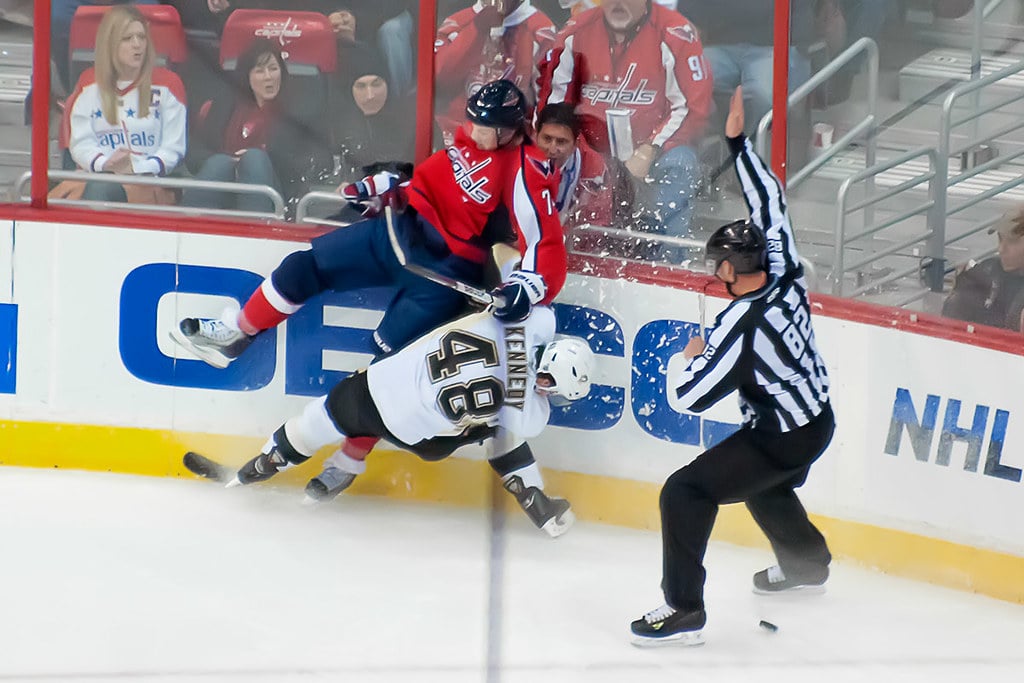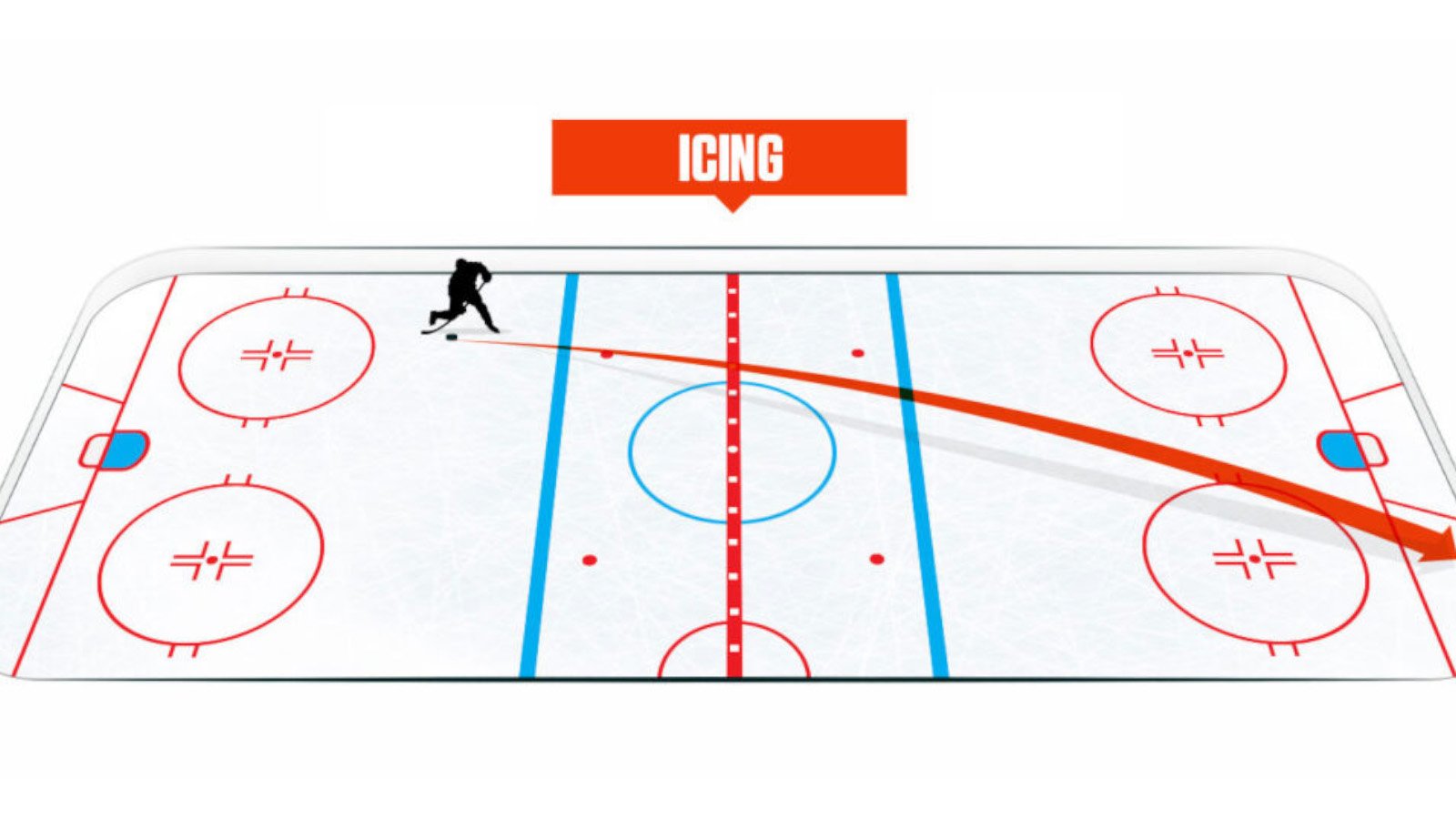Icing in Hockey – What Is the Icing Rule in Hockey?
Ever wondered what the icing rule means in hockey? You’re not alone. Let’s clear it up and explain icing in the simplest, most straightforward way possible.
Table of Contents
What Is the Icing Call in Hockey?
Icing occurs when a player shoots the puck from behind the center red line all the way past the opposing team’s goal line without it being touched and without scoring a goal.
For icing to be called:
- The opposing team must not be short-handed (on the penalty kill), as icing is typically waived off in that situation.
- The puck must be shot from behind the red center line.
- It must cross the opponent’s goal line.
No player from the shooting team can touch the puck before an opposing player has a chance to.
A Simple Example of Icing
In the most straightforward terms:
Icing happens when a player shoots the puck from behind center ice to the far end, and it crosses the goal line untouched.
Looking at the image below:
- Player A does not commit icing because they released the puck after crossing the center red line.
- Player B, however, does commit icing because they shot the puck from behind the red line, and it traveled past the opposing goal line without being touched.

Why is icing illegal in hockey?
The icing rule in hockey was introduced by the National Hockey League (NHL) in 1937 to prevent teams from abusing the tactic of shooting the puck down the ice to relieve pressure, stall the game, or protect a lead.
The Purpose Behind the Icing Rule
Without the icing rule, teams could:
- Fire the puck down the ice whenever they were under pressure.
- Defend a lead by delaying the game, turning it into a passive, less competitive contest.
- Attempt constant, low-percentage stretch passes with little to no consequence for failure.
This would significantly disrupt the flow of the game and reduce its entertainment value for fans. Instead of rewarding skill and puck control, teams would rely on dumping the puck to slow things down.
Where Did the Term “Icing” Come From in Hockey?
The term “icing” in hockey originates from the act of sending the puck all the way down the ice—essentially “icing” the surface with the puck.
Because icing occurs when a player shoots the puck from behind the center red line across the opposing team’s goal line, the word “icing” reflects the puck being launched the full length of the ice rink.
In other words, the puck is metaphorically “frozen” or “iced” all the way down the sheet—hence the name.
What Is the Punishment for Icing in Hockey?
When a player ices the puck, the linesman blows the whistle to stop play. The faceoff is then brought back to the defensive zone of the team that committed the icing, typically on the same side of the ice from which the puck was shot. It’s important to note that icing is called by the linesmen, not the referees.
While icing is not a penalty in the traditional sense, it does carry consequences. The biggest risk is that the offending team must now defend a faceoff in their own zone, giving the opposing team an opportunity to apply pressure or score a goal—especially if they win the draw cleanly.
Although icing in hockey might seem like a minor infraction, it can be costly in close games. Each call increases the risk of momentum swinging to the opposing team.
To further discourage teams from abusing the rule, the NHL introduced rule changes over the past decade to increase the consequences of icing. Let’s break those down next.
What Are the New NHL Icing Rules?
The NHL has made significant changes to icing rules in recent years to improve player safety and maintain game flow. These updates have not only changed how icing in hockey is called but also how teams strategize around it.
No Line Changes After Icing
Since the 2005–2006 NHL season, teams that commit an icing are not allowed to make a line change before the next faceoff. This rule prevents tired players from dumping the puck to get a free stoppage for fresh legs. By enforcing this, the NHL encourages continuous play and punishes teams for using icing as a delay tactic.
While this rule is now standard across most professional leagues, minor hockey leagues or recreational adult leagues may not always enforce it, so it’s worth checking with your local league.
Hybrid Icing: Safer and Faster
The second major update was the switch from touch icing to hybrid icing, implemented by the NHL in the 2013–2014 season to reduce the risk of injuries during icing races.
Touch Icing (Now Outdated)
Under the old touch icing rule, the play would only stop once the defending team touched the puck after it crossed the goal line. This led to dangerous races down the ice and often resulted in serious collisions into the boards.
Hybrid Icing (Current NHL Standard)
Hybrid icing preserves the competitive race element but adds a key safety buffer: if the defending player reaches the faceoff dots first, the linesman will blow the play dead immediately, canceling the race. This gives players an extra 30+ feet to slow down, drastically reducing the risk of injury.

No-Touch Icing (Used in Amateur and International Play)
No-touch icing is the simplest and safest version of the rule. The whistle blows as soon as the puck crosses the goal line, with no race required. This form is used in most amateur leagues, recreational hockey, youth levels, and international tournaments like the Olympics, where player safety takes top priority.
Is It Icing If the Puck Hits the Post?
A common question in ice hockey is whether icing is still called if the puck hits the post. The answer is no.
For an icing call to be made, the puck must completely cross the opponent’s goal line without being touched. If a player shoots the puck down the ice from behind the red center line and it hits the goalpost or any part of the goal frame, the puck will not fully cross the goal line. As a result, icing is waved off.
This is because the puck made contact with the goal structure, preventing it from completing the necessary path for icing to apply. In most cases, the linesman will signal no icing and the play continues.
Why Can Icing Be Waived Off in Hockey?
In ice hockey, an icing call can be waived off for several specific reasons. Understanding these exceptions is important for both players and fans trying to follow the flow of the game.
1. Shorthanded Team
If a team is killing a penalty (i.e., shorthanded), they are allowed to ice the puck without a stoppage. Icing is automatically waived off in this situation.
2. Puck Touched or Deflected
If the puck is tipped, deflected, or touched by a teammate of the player who iced it, or by an opposing player, the linesman will waive off icing. This includes slight contact, even if the puck still travels the length of the ice.
3. Effort to Play the Puck
If the linesman judges that the defending player is not making a genuine effort to retrieve the puck before it crosses the goal line, they can waive off icing. This rule is intended to encourage continuous play and prevent defensive stalling tactics.
4. Goalie Involvement
If the puck touches the goaltender or the goaltender makes any motion to play the puck or leaves his crease to do so, icing is waived off. In past years, goalies would often raise a glove or stick to signal their intention not to play the puck, but this practice is seen less frequently today.
5. Faceoff Exception
Though rare, there are certain faceoff situations where a puck shot immediately off the draw may result in what looks like icing. However, if officials determine it came directly from the faceoff with no intention to ice it, the icing call may be waived off.
Icing when shorthanded
Shorthanded is when one team has fewer players on the ice (because a player is in the penalty box). The shorthanded team or the team said to be on the penalty kill, can fire the puck as far as they like without getting an icing call.
However, the opposing team with more players on the ice, the team on a power play, is still bound by the icing rule.
In a shorthanded situation, icing the puck is a favorable play because it allows you to clear your zone when you have one less player on the ice than your opponent and kill time off the clock to run the penalty out.
Icing In Your League
The icing rule for non-pro hockey varies by league. Most leagues enforce a “no-touch” icing, which, as we went over, occurs when play is stopped as soon as the puck crosses the goal line, regardless of whether or not an opponent touches it.
However, some recreational adult leagues may utilize the blue line instead of the red line when it comes to icing because of limited ice time. This will result in fewer infractions and, thus, fewer whistles to delay play.
Still need a little extra explanation to better understand icing? Maybe some visual examples provided by Snoop Dogg will help. Enjoy!
And here are a few more guides that will help you to better understand the rules of the icing and more:
What Is the Red Line in Hockey?
What Is a Power Play in Hockey? Hockey Power Plays Explained







